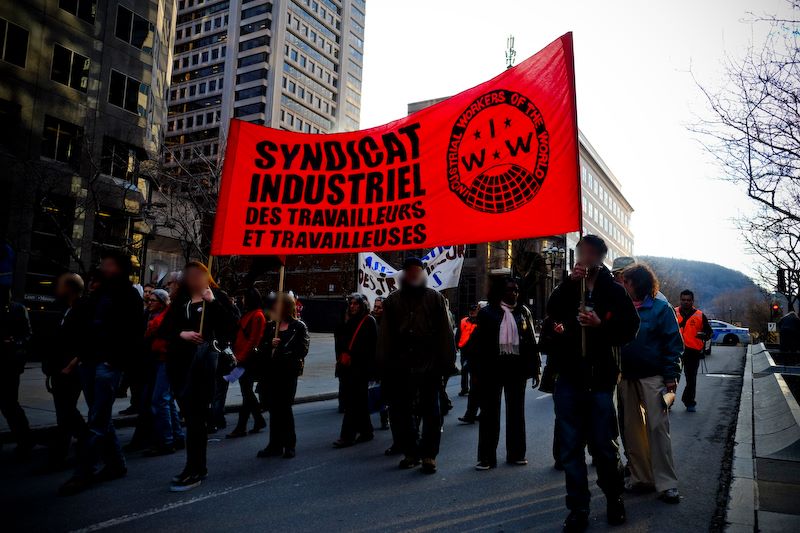
Anonymous submission to MTL Counter-info
February marks the 10-year anniversary of the presence of the Industrial Workers of the World (IWW) in Quebec. Once a sparkle in the eyes of a tenacious group of student strike veterans looking to broaden their fight, the union now marks its decennial without a single workplace in the province organized under its banner.
What was this initiative and why did it run into trouble?
The United States Idea: Solidarity Unionism
As US union membership continued to decline in the 90’s, one group of thinkers championed a strategy, known as Solidarity Unionism, which diagnosed the harm and the remedy for labour’s problems as stemming from the same source: labour law.[1]
Labour law — specifically, the US National Labor Relations Act (NLRA) — was said to weaken unions by forcing them to follow a formal certification process to represent workers at a particular company.[2] The certification delivered membership growth with legal leverage at the expense of actions a union was to forgo, such as sympathy striking, as a condition of maintaining their certification.
Section 7 of the NLRA provided an alternative course of action, allowing workers to circumvent the long, drawn out process of certifying the union through an election and negotiating a collective bargaining agreement, which can take years to materialize. Section 7 entitles two or more workers to take action together to improve their working conditions— without union certification and without a collective bargaining agreement.
If jumping through the hoops to get “permission to bargain” produced impotent unions, then bypassing this waypoint by directly engaging in the concerted activity protected by Section 7 would be the answer. As an example, workers at Starbucks recently engaged in a strike that would merit no legal protections in Canada.
IWW Arrives in Quebec
In 2013, the IWW chartered its first local in Quebec.
Despite the province’s contemporary status as the most radical and labour-friendly jurisdiction in Canada, Quebec’s Labour code immediately presented a problem for the Solidarity Unionism experiment. Quebec’s labour relations regime has no equivalent to the NLRA’s Section 7. There is no legal protection for workers engaging in concerted activity. If they struck — defined in the labour code as virtually any type of concerted activity that impacts production — the employer was legally entitled to fire them.
However, in Sections 12 – 15, the provincial labour code does contain language designed to protect workers throughout the process of forming a union and during participation in union activities. Invoking the broad language of Sections 12 – 15 in complaints to the Labour Board, the IWW attempted to force these sections to be interpreted as a sort of deformed clone of the NLRA’s Section 7.
This is how the sequence of events would run:
(1) Workers participate in some concerted activity → (2) Employer takes an anti-worker action → (3) File complaint about contravention of articles 12-15 → (4) Utilize aid of Board Agent to negotiate significant financial settlements causing → (5) A discouraging effect on target employer, and signalling effect on other employers.
Would the union’s strategy be eligible for protections offered by Quebec’s Labour Board? More practically, would employers be prepared to enter into the courtroom to find out? While some employers declined to provoke the Labour Board’s attention over union actions that could be re-interpreted as legally protected, others discovered that the Board would crank out hefty out-of-court financial settlements for workers engaged in concerted activity.
While the Labour Board complaints provided the IWW with a defensible legal basis for engaging in concerted activity, the union was able to effectively reap the rewards of its organizing style in the form of broader support from members at target companies, as well as higher intensity workplace activism. Concerted activity in the union formation phase led to these benefits by creating more frequent and emotionally intense occasions for members to increase their sense of identification with the organization.
No Plan Survives Contact with the Enemy
While Solidarity Unionism saw its share of success on both sides of the 49th parallel, the strategy ultimately failed in similar ways in both the US and Quebec.
In the US, though Section 7 provided cover for unions to build strength and support during the initial phase of forming on the shop floor, it did not go far enough to create the necessary conditions to allow the union to actually take root in the workplace. Nor did Section 7 create the conditions necessary for the IWW to achieve concessions on the scale of other unions in terms of wages, scheduling, job protection, and influence over management of the company.
On both sides of the border, labour board interventions in defence of concerted activity were too ineffective. Workers were unable to progress from intense fights with employers over initial, limited problems into establishing a sustainable union capable of shaping company policy. Unfortunately, the speed with which employers can run a campaign of terror — snuffing out initiatives through firings and facility closures, such as at Zeppelin bar and grill, and Red Bee Media — consistently outpaced labour board interventions. In practice, employers also demonstrated their capability to endure the IWW’s tactics of petty economic warfare, as well as the financial penalties which were achievable from concerted activity protection norms. More critically, employers were effective at outlasting their employees’ resolve to work in a perpetual war zone.
In Quebec, workers were also ineligible to make the legal shift arising from formal certification that marks an important switchover from a less advantageous set of laws governing individual employment contracts, to the more advantageous set of laws governing collective bargaining and collective agreements. The Solidarity Unionism model in Quebec necessitated a significant abdication and abandonment of legal entitlements and protections.
As a consequence, the IWW’s organizing in Quebec has hit a wall. Many workers who were able and willing to make a lateral move to the CSN, the second largest trade union federation in Quebec, did so. Others left without union representation in their workplaces.
A sample of organizing efforts and their results:
| Company | Initial Outcome | Long-term outcome |
| Frites Alors! on Rue Rachel | Voluntary agreement (no status under Quebec labour law) | Union killed through turnover; unclear whether workers at this location still benefit from this agreement. |
| Aux Vivres on Boul. Saint Laurent | Absorbed by CSN | Union legally exists, but killed through lack of support by central |
| Union for employees of student unions and student union owned enterprises (STTMAE) | Voluntary Agreements with Cegep student unions (no status under Quebec labour law) | Unions represented members moved to CSN |
| Community Sector Organizing (STTIC) | Absorbed by CSN Dual IWW-CSN campaign that led to significant improvements in Collective Agreement for some members. | Union continued but is now exclusively represented by CSN; IWW ousted or left from Executive |
| Humble Lion Cafe | Voluntary agreement (no status under Quebec labour law) | Union killed through turnover; unclear if workers at the company still benefit from the agreement. |
| Red Bee Media | Company closure, mass firing, Labour Board mediated financial settlements | Workers lost their jobs; company closed |
| QA Courier | Mass firing | Bike couriers followed initial effort by turning to Canadian Postal Workers Union which progressed in Ontario (see Gig Workers United) but did not progress in Quebec |
| Keywords | Multiple firings, Labour Board mediated financial settlements | Effort to organize video games continues under auspices of Game Workers United & Communications Workers of America |
Proof of Concept
The IWW’s Solidarity Union experiment has provided the labour movement with some important lessons. The deliberate, planned, and persistent application of concerted activity in establishing a union translates to higher and more durable degrees of participation and support among members. More importantly, it delivers higher caliber union actions that are effective in throwing employers and labour boards off-guard.
Painfully, these are typically short-term gains measured in months and not years, which more often than not eventually lead to workers seeking collective bargaining agreements in most successful campaigns due to the added legal tools they make available and worker-organizer burnout.
Today, in light of the obstacles described above, workplaces publicly organized by the IWW in the United States combine Solidarity Unionism tactics with Collective Agreements and bargaining, narrowing the gap in their earlier approach. Meanwhile, other underground workplace organizing campaigns continue in what may be defensibly termed small batch, artisanal unionism — unscalable outside of one or two workplaces, and transient.
The IWW’s organizing in Quebec followed a similar trajectory. It set important practical precedents in trade union activity by demonstrating the willingness of the provincial labour board to act in defence of concerted activity. However, it failed to accomplish its goal of establishing durable unions capable of achieving deep concessions without regard for bargaining units and the kind of time-bound peace treaties with employers that have characterized the US-Canadian labour movements since the early 20th century.
Unlike some of their American counterparts, leaders of IWW’s quickly shrinking footprint in Quebec have not demonstrated an interest in shifting to a hybrid approach to organizing that would include tactics beyond the Labour Board’s menu of protected concerted activities, making the organization’s future uncertain. The union’s presence in Quebec, which once included enclaves in Drummondville, Sherbrooke, Quebec City, and Montreal, is now down to just a few dozen active members in Montreal.
[1] The term Solidarity Unionism has undergone several changes in meaning. In the broadest terms it refers to a set of tactics that can be used by any union, while in others it refers to minority unionism. In this context, it strictly refers to a dominant tendency in union thinking that defines it as a strategy based on the NRLA’s Section 7 as described above.
[2] This holds true even in circumstances where workers at a particular company form a union to pursue a certificate to represent themselves.


